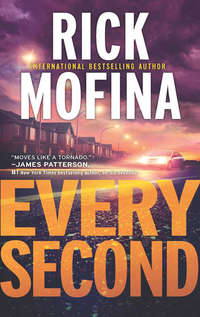
Полная версия
Full Tilt
Kate used maps and made some calculations. Their accident happened about ten miles east of Golden, British Columbia, when their car left the highway and crashed into the Kicking Horse River. That was some 270 miles west of Brooks, Alberta, a five-hour drive across the prairie and through the Rocky Mountains.
Vanessa would have been twenty-six now. If Tara Dawn Mae is still alive, as the message in Rampart suggests, she’d be around twenty-five or twenty-six now, as well.
Was it all coincidence?
Kate went back to the crime scene photos.
My name used to be—
What was her other name?
Was Tara Dawn the Maes’ biological child or an adopted child? Kate couldn’t find any divorce records on public sites. Maybe Tara Dawn was a street kid who’d run away and changed her name? It was not uncommon. Kate knew that, from her time on the street. Kids were always running from something.
As she continued working throughout the day she came across an in-depth article done on the third anniversary of the case that stopped her cold. It said that Barton and Fiona Mae had adopted Tara Dawn about three or four years before her disappearance.
Adopted?
Kate’s mind raced.
She tried searching for court records, knowing that they weren’t usually made public, a fact confirmed when she called the clerk’s office for Alberta’s family courts in Edmonton, the capital. Kate was thinking of hiring a Canadian private investigator to help her dig deeper into the case when she realized the time.
She had to pick up Grace from school.
* * *
They’d passed the remainder of the afternoon with Grace coloring a project about the world’s oceans and chatting about her day while Kate got supper ready. Whenever she could, Kate thought about the case. That evening while they were watching The Wizard of Oz, Fred Byfield called.
“Kate, I talked with our people in Calgary affiliated with our network and I don’t have a lot more to add.”
“I’ll take anything, even advice.”
Kate patted Grace’s leg and left the sofa to take the call in the kitchen.
“Canadian police still have it listed as a cold case.”
“Yes.”
“No real leads, nothing at all, and both of the parents have since passed away.”
“I didn’t know that about the parents. How’d they die?”
“Accidents, maybe, we’re not sure but did you know that Tara Dawn was adopted?”
“Yeah, I found a magazine piece that mentioned it. Any details on that?”
“I don’t know, and our source in Calgary didn’t know.”
Kate considered the information.
“So what do you make of these factors? Is it Vanessa, Fred?”
“When you add them up—the necklace at the scene, the carved message from Tara Dawn Mae, the dates, ages and the fact they never found Vanessa’s body—they do present a compelling argument that your sister was at the Rampart crime scene.”
“But? I detect a ‘but’ in your tone.”
“But, you know as well as anyone, real life is not like mystery books and thriller movies where it all ties together nicely. Real life is complicated and missing persons cases can be complex. Simple factors that appear to be connected often have explanations proving there is no link whatsoever.”
“Yes, I know.”
“And there’s no DNA from Tara Dawn’s case to compare to yours, at least none that we know of. And we don’t know what Rampart police know, or what they may be telling the RCMP in Alberta about their case. Now you’ve got to decide what you’re going to do next. I think this warrants further investigation and we’ll help you as much as we can.”
“Thanks, Fred.”
Kate returned to the movie, sitting next to Grace. As Dorothy followed the yellow brick road in her quest to get back to Kansas, Kate searched for the right path she needed to take.
“You were talking about Aunt Vanessa on the phone,” Grace said. “I could hear you say her name.”
“Yes, I was.”
“Is that why you went away the other day, to look for her again?”
Kate looked at her and smiled. Grace was a smart little girl. Last year when she’d turned six, the same age as Vanessa at the time she went missing, Kate had told Grace about the crash, how she’d lost her hold of Vanessa’s hand, how they’d never found her and how she still looked for her everywhere. Grace understood, or seemed to, and Kate was okay talking about it with her.
“Yes, honey, that’s why I went away the other day.”
After the movie, as Kate got her into bed, Grace asked her a question.
“Are you going to go away again to look for Aunt Vanessa, Mom?”
“I’m not sure. I have some time off from work right now, so I’m not sure.”
“Maybe one day you’ll find her, Mom, just like Dorothy found her way back home to Kansas.”
Kate smiled.
“Maybe.”
Later that night, as Kate continued researching, she couldn’t help but think how her pursuit of the truth about Vanessa had turned into her own yellow brick road of doubt and defeat by dead-end leads. Kate was a reporter and, like a cop, needed facts. What she had now were puzzle pieces, and what she needed to do was keep digging for more to see if they all fit. Kate found herself on airline sites checking flights to Calgary.
Kate called Nancy.
After telling her everything, after explaining her situation, Kate was still unsure about leaving Grace, about the whole idea of going to Canada, with her job situation and everything else.
“There’s no question you have to go,” Nancy said. “This is part of the fabric of your life, of who you are. How would you live with yourself if, after all that’s happened, you never did all you could to find the truth about your sister because you’d left a big stone unturned? Go. I’ll take care of Grace.”
Five minutes later Kate booked a flight to Calgary.
14
Rampart, New York
Pathologist Morten Compton sat at his desk in his basement office at Rampart General and reviewed his notes on the two deaths at the old burial grounds.
We’ve got to nail down the ID on the male. And the cause of death.
It was late and as Compton worked he started wheezing again. His wife had warned him to cut back on the meatball sub lunches at Sally’s Diner and to drop a few pounds. The job stress didn’t help.
Compton’s temporary assistant, Marsha Fisher, who’d gone for the day, had left him a summary.
Detective Brennan’s extremely anxious for updates.
As you know Dr. Hunt made dental charts, which we’ve circulated with no results so far. If the male victim had a dentist, it appears he didn’t visit one recently or locally.
One potentially positive new aspect: the forensic unit at the scene recovered a military dog tag in the vicinity of where the male was found. I’ve attached a photo of it. I’ve submitted it to the military’s National Personnel Records Center in St. Louis with an urgent request for comparison of our dental chart with the dog tag info. You should be hearing back anytime now.
Compton clicked on the image.
The dog tag was charred and twisted metal, but the information was clear to read. The name was: Pollard, J.C., blood type was O positive, followed by the Social Security number, and other information.
Compton stroked his Vandyke.
Were there more victims?
The blood type was the same as the presumed victim, Carl Nelson, but O positive was very common. The dog tag could have already been at the site and have no bearing on the victim. Then again, it could be a key piece of evidence.
Identifying a body this severely burned was always challenging. The face was gone, so identification by a relative or friend would not be possible. The hands were gone, so fingerprints were not possible.
Clothing was destroyed. No distinctive jewelry for the male had been recovered.
Compton had taken X-rays of the remains, hoping to find any medical implants or screws for a broken leg and such. He’d circulated them with doctors in the region. So far to no avail. And as far as the DNA went, he was unsure if, given the extensive damage to the body, the tissue sample he’d submitted to various databases, including CODIS, the FBI’s national DNA database, was viable.
That brought him to the cause, which had all the indications of a self-inflicted gunshot wound. The entrance was the right temple. The wound track was right to left and slightly forward to the left temple, where he’d recovered the 9mm round, but there was also a significant skull fracture from blunt trauma. The injury could’ve been a result of being struck by debris, such as a large beam, falling from the burning building. The problem for Compton was that given the severity of the damage to the body, he couldn’t conclusively determine the order of events. He was leaning to concluding that death was the result of a self-inflicted gunshot wound, and the skull fracture was postmortem, given the other supporting factors of Carl Nelson’s suicide note, his vehicle and his absence from his job.
The phone rang.
“Pathologist, Compton.”
“Dr. Compton, this is Major Robert Ellis with the office of the chief of dental services with the United States Army. I’m calling in response to your request, concerning the dental records of Sergeant Pollard.”
“Yes, Major, thanks for calling.” Compton reached for a pen.
“We can confirm that the chart you sent for comparison is the chart of Sergeant John Charles Pollard formerly of the US Army Special Forces. He toured Iraq and Afghanistan and was honorably discharged seven years ago.”
“You’re positive on the chart?”
“Yes, sir. It’s clear regarding the patterns and wear of several large amalgams.”
“This is one hell of a game changer.”
“We’ve arranged to expedite written confirmation and can provide you with scanned and physical copies of Sergeant Pollard’s full military records and photographs to assist your investigation.”
“Thank you, Major Ellis.”
Compton hung up.
His breathing had quickened.
He stared at his computer’s monitor and the charred, twisted dog tag that belonged to the former US Army sergeant. Before Compton made another note, before he called Brennan, he absorbed the new information.
If the body is Pollard, then where is Carl Nelson?
And why would Nelson leave a suicide note seeking forgiveness for what he’d done?
What the hell have we got here?
15
Buffalo, New York
Yellowing tape held meal schedules to the walls of the dining hall of the mission in downtown Buffalo.
The rules were up there, too: “No weapons, no drugs, no booze and no fighting. We offer: Love, respect, understanding and healing.” After reading them Dickson shook his head.
“It sickens me that any veteran, after sacrificing everything for our country, comes home to this.”
Ed flipped through his notes. The two Rampart detectives were at a table waiting for the mission crew to finish up with breakfast so they could interview people about former Sergeant John Charles Pollard.
That Pollard, not Carl Nelson, had been identified as the male victim took this thing to a whole new level. They needed to determine his connection to Nelson, to Bethany Ann Wynn, to any aspect of the case.
After the pathologist had alerted them yesterday to Pollard’s ID, Brennan and Dickson pored over his military records, made calls and tracked his last known location to Buffalo.
Pollard, aged thirty-nine, was from Toledo, Ohio, and had enlisted as an artillery man in the US Army in 1998. He was assigned to the 3rd Battalion, 319th Airborne Field Artillery Regiment and had several deployments to Iraq and then Afghanistan. By 2009, he was with the US Special Forces in Kandahar’s Zhari District. Later, at a Forward Operating Base in Paktia province, his unit was pinned down in a firefight that lasted a week. Pollard witnessed the deaths of most of his squad members.
He came home to Toledo, suffering post-traumatic stress and became addicted to alcohol and other drugs. He lost his job as a truck driver, his wife left him. He fell into debt, then drifted across the country, ending up on the streets and finally in this homeless shelter.
Brennan was grateful to Buffalo PD, which had made initial inquiries with local shelters. It cleared the way for him to get up at four this morning and make the four-hour drive to Buffalo with Dickson to continue their investigation. They hadn’t released Pollard’s name yet. They were working with the military to locate his family.
“Doesn’t it make you sick that vets end up homeless when they should be treated like heroes?”
“It’s a disgrace.” Brennan sipped his coffee and over the rim saw Tim Scott, the shelter’s director, wiping his hands with a towel as he approached them.
“Thanks for waiting.” Scott joined them at the table, then waved to staff members behind the counter. “Sure we can’t get you fellas something to eat after your long drive?”
“We’re good with the coffee. Thanks,” Brennan said. “What can you tell us about John Charles Pollard?”
“I can’t believe he’s dead. In a fire...maybe he took shelter in the barn?”
“Maybe.”
“It always hurts when we lose a client.” Scott shook his head. “People come to us broken. We give them a meal, a bed and hope in the way of counseling and services. J.C. had been with us for five months and was showing promise. He’d gotten clean and sober. He’d gotten his license again and was ready to apply for driving jobs.”
“So things were looking up?”
“Yes, despite all he’d faced, he was slowly getting back on his feet. But some guys have their setbacks and they disappear. That’s what I thought might’ve happened.”
“That he’d had a setback?”
“That’s what I was thinking. The other guys who knew him best had been asking about him because he hadn’t been around for a week or so. Reggie and Delmar. They bunked with him for a time and were probably the closest he had to friends. They’re right here.”
The first man was in his thirties. His clothes hung loose on his skinny frame. His face bore fresh scrapes, as if he’d collided with the sidewalk.
“Is it true? J.C.’s dead?” The man called Reggie sniffed and sat down.
“I’m afraid so. My condolences.”
Reggie nodded sadly.
“May I ask what happened?” Brennan indicated the man’s cuts.
“Was drunk, fell on the street.”
“Reggie, may I get your last name, date of birth and could you show me your Social Security card? It’s routine.”
Brennan cleared a page in his notebook, took down Reggie’s information then did the same for Delmar, the taller of the two. Delmar had a full, scraggly Moses beard dotted with crumbs.
Brennan thanked them and said, “We ask that you keep our inquiries confidential. It’s critical to our investigation.”
“So he got killed in a fire in Rampart?” Delmar looked around the table.
“Something like that. Guys, can you recall if John—”
“Oh, we call him J.C., nobody called him John,” Reggie said.
“Sorry. Can you recall if J.C. had any connection to Rampart?”
The three men shook their heads.
“Ohio, mostly, that’s where he came from,” Reggie said.
“Do the names Carl Nelson or Bethany Ann Wynn mean anything to you in relation to J.C.?”
“Don’t think so.” Delmar looked to the others, who agreed.
“What about Canada? Did he ever talk about it?”
More shaking of heads.
Dickson cued up photos on his tablet.
“Do you recognize anything in these pictures, any connection at all?”
The first were several photos of Bethany Ann Wynn.
None of the photos registered with the men.
Next were photos of Tara Dawn Mae, from her missing persons file from Alberta.
Again, nothing.
Then they showed them enlarged photos of the necklace with the guardian angel charm.
Nothing.
“What’s this really about?” Scott was clearly troubled. “I get the feeling there’s something more serious going on. Do you think J.C. had something to do with these people?”
“At this point, we’re not sure what to think,” Brennan admitted.
Then came photos of Carl Nelson.
“That guy.” Delmar tapped his finger on Nelson’s face.
“He used to come around, talk to J.C.,” Reggie said, nodding.
“When did he start coming around?” Brennan stared hard at the men.
“It started a month or so back, maybe two months,” Reggie said. “We were in the park, passing a bottle of Thunderbird. J.C. wouldn’t take none, he was on the program doin’ fine without preachin’ to us. That’s when this guy—” Reggie pointed at Nelson “—came up and just gave us money. Fifty bucks each. Said he remembered when his family had hard times. We get that sometimes.”
“Did he give you his name?”
“Jones, Adam Jones, I think,” Reggie said.
“Then the guy came around more,” Delmar said. “Bought us lunches and took an interest in J.C., his military time, telling J.C. how thankful and honored he was.” Delmar jabbed his forefinger into the table. “I tell you, sir, that meant the goddamn world to J.C. because he was still carrying the ghosts of the men he lost.”
Reggie nodded.
“J.C. was a true-blue soldier. You know, he still had his dog tags. Put them in his boot so no one would yank them from his neck if he got jumped. I think we were the only ones he told.”
“Can you recall any other details about the man’s interest in J.C.?”
“He started bringing him clothes, pants, boots, jackets, stuff he said he no longer needed, or never wore,” Delmar said.
“Yeah,” Reggie said. “Good stuff, because they were practically the same height, build, age, the same everything. The guy told J.C. the clothes were his and he didn’t need them anymore.”
Brennan and Dickson exchanged a glance.
“Do you recall anything else?”
“They were getting chummy,” Delmar said. “I remember, about two weeks before we last saw J.C., he was saying that he might have a lead on a good job but it was across the state.”
“In Rampart?” Brennan asked.
Delmar shook his head. “Didn’t say, but he sure was feeling good about things, you just saw it on his face and stuff.”
“Then that was it,” Reggie said. “We never saw J.C. after that.”
* * *
Brennan and Dickson shared their theories on the case on the long drive back to Rampart.
“What do you think, Ed? Nelson was making bondage, porn movies at the barn, maybe invited Pollard to take part?”
“Maybe, but look again at what his note said.”
Dickson read it aloud. “‘I only wanted someone to love in my life. It’s better to end everyone’s pain. God forgive me for what I’ve done. Carl Nelson.’ Okay, so something else was going on. Where does Pollard fit?”
“We need to get warrants on Nelson’s house, his bank records, credit card and his computer.”
“Wait, how did Nelson use Pollard?”
“Look at their physical particulars, both are white males, both are six feet tall. Nelson’s in his forties and Pollard’s thirty-nine, almost the same age and both have the same body type.”
“So what are you saying?”
“I think Nelson selected Pollard to stage his own suicide.”
16
Calgary, Alberta
The Southern Alberta District headquarters for the RCMP’s K Division in northeast Calgary was housed in a glass-and-brick building overlooking Deerfoot Trail, the city’s major expressway.
Thankfully, it was also near the airport, Kate thought as she wheeled her rented Toyota into the parking lot.
Kate had arranged to meet a Corporal Jared Fortin at 9:00 a.m. to discuss Tara Dawn Mae’s disappearance and Vanessa’s case.
She had ten minutes before her meeting and checked her phone for messages. Nothing new. Smiling at her daughter’s face, she remembered what Grace had said before giving her a million hugs goodbye yesterday.
“I hope you find out what happened to Aunt Vanessa, Mom.”
Kate entered the building and went to the front desk.
“I’m Kate Page. I have an appointment with Corporal Jared Fortin, who I believe is with Major Crimes.”
“Yes, one moment, please.”
As the receptionist’s keyboard clicked, Kate looked at the wall map behind her. The Southern Alberta District had more than thirty detachments and covered everything in the southern region of the province west of Calgary to British Columbia, east to Saskatchewan and south to Montana, an area larger than most states.
The receptionist stopped and looked at Kate.
“Kate Page, from New York City?”
“Yes.”
“Did Corporal Fortin not contact you about today?”
“No. Is there a problem?”
The woman resumed concentrating on her monitor, then, finding something, her expression changed, indicating all was well.
“No, it’s fine. Sorry.” She then requested Kate exchange two pieces of photo ID for a visitor’s badge and her signature on a sign-in sheet. “Thank you. Please have a seat. Someone will be right with you.”
Kate went to the waiting area, wondering if the receptionist had inadvertently signaled a problem. She sat in a chair and glanced at the spread of magazines on the table. Something was up. She took out her phone. She hadn’t received any new messages. She scrolled through news sites out of Rampart, scanning stories for any updates.
She’d found nothing new.
“Ms. Page?”
A man in a dark blue suit had materialized. He was about six feet tall with a solid build, short brown hair and thick mustache. He looked to be in his late forties.
“Staff Sergeant Ian Owen.” He extended his hand. “I’m Corporal Fortin’s supervisor. Right this way.”
He led her to his office. Through the large windows Kate saw jets approaching the airport. Sergeant Owen directed her to a chair before his desk.
“Can I get you a coffee or anything?”
“No, thank you. I’m fine.”
Owen sat, took up his pen and leaned forward, staring at it for a moment.
“Ms. Page, I’ll come to the point. I know why you’re here. Unfortunately, there’s not much we can do to help you.”
“But Corporal Fortin assured me he was willing to discuss my sister’s case and the cold case of Tara Dawn Mae.”
“He explained your call to me. All I can say is that we’re supporting an active investigation in another jurisdiction.”
“But the case in Rampart, New York, and the case in Brooks, Alberta, are linked and there’s every possibility they’re linked to my sister.”
“I understand, and I can only imagine how terrible this sounds to you, especially after you’ve traveled here from New York.”
As Kate’s heart sank, she grew angry. Angry at herself for believing police here would help her when, in the back of her mind, she knew cops were all the same. As her resentment rose she realized what had happened.
“You’ve been talking to Ed Brennan about me, haven’t you?”
“As I said, we’re supporting another jurisdiction in an ongoing investigation.”
“I got that. Forgive me for being blunt, Staff Sergeant, but I’m not an idiot. Let me give you some context, which I’m sure you know from talking to Rampart. Ed Brennan called me, requesting my help. He asked me to bring my necklace to him so he could compare it to one found at his scene, which resembles my sister’s necklace.”
Owen said nothing, letting Kate continue.
“At the same time, there’s evidence at the Rampart scene that’s tied to the disappearance of Tara Dawn Mae, which is in your yard. Now, here we sit, some one hundred and fifty miles from where I lost my sister in the Kicking Horse River.”
“That was twenty years ago near Golden, BC. That’s E Division’s jurisdiction.”
“Stop, stop this bureaucratic police bull, please! I was underwater in that river when our car crashed into it. I held my sister’s hand—”









